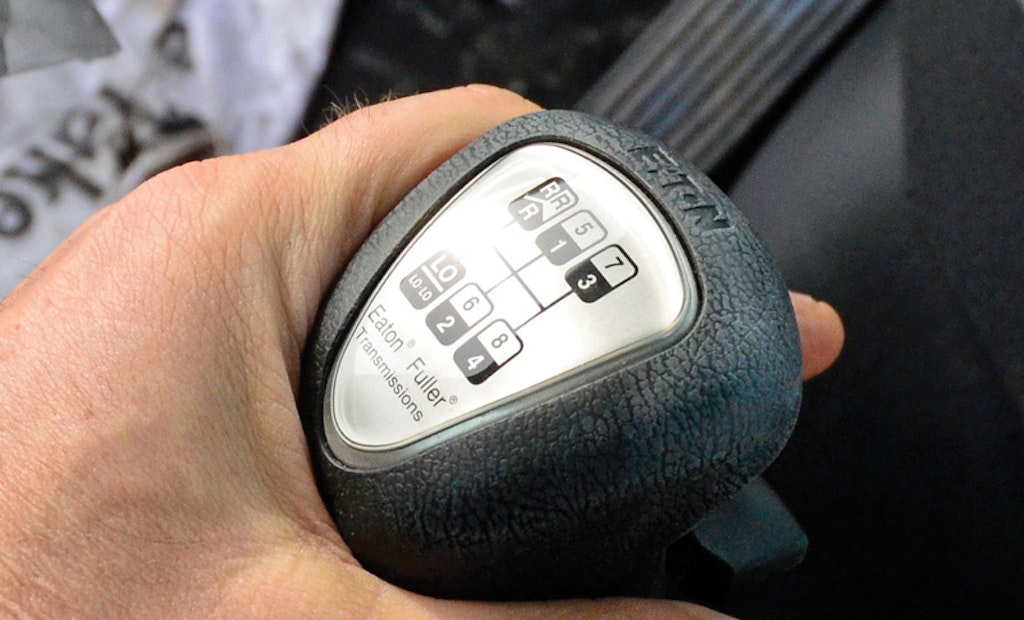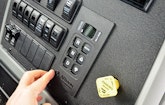
Interested in Trucks?
Get Trucks articles, news and videos right in your inbox! Sign up now.
Trucks + Get AlertsIn the age-old debate of manual versus automatic transmissions in commercial trucks, Brian Stroetz, vacuum truck sales representative for Western Star dealer V & H Trucks in Marshfield, Wis., believes automatics will soon be the transmission of choice.
Far from extinct, Stroetz says manual transmissions still hold an edge, but automatics are gaining fast. “I don’t think they’re outselling manuals yet. [But] I would say it’s about even, where it used to be 2-to-1, manuals over automatics.”
One reason manuals still might hold an edge is cost. While an automatic can add $12,000 to the initial purchase price of a truck, Stroetz says much of that can be recouped when it comes time to sell. “You’re paying more for it up front, but you get more for it on the back end,” he says.
IN-TOWN CONVENIENCE
Paul McCain, owner of Burns Sewer & Septic in Victorville, Calif., says that although his nine trucks – including two vacuum rigs – have manual transmissions, he actually prefers an automatic transmission, especially for in-town driving.
“The drivers that I have are all driving manuals anyway and they’re all good drivers, so I wasn’t going to pay the extra money to get an automatic,” he says. “Now if I had inexperienced drivers, I would probably go [with automatics]. Inexperienced drivers actually snap the driveshaft because they pop the clutch or they ride the clutch too much; they don’t shift the truck right.”
Stroetz says driver inexperience is costly. Repairing a manual transmission can cost $4,000 to $5,000, while an automatic might run $10,000. “If you just talk about the transmission itself, it’s more expensive to repair an automatic, no doubt about it. But if you throw in the cost of a [$3,500] clutch, then it evens itself out.”
While automatics enable fleet owners to hire from a larger, less experienced labor pool, safety is another factor to consider, especially in city traffic.
“You want your drivers to be concentrating on the road and what’s going on around them versus what gear they’re in,” Stroetz says.
TRANSITION TIME?
Ease of driving is one reason why Woody’s Septic Tank Service of Holly Hill, Fla., has an automatic in all but one of its vacuum service trucks.
“The way it’s going, not everybody knows how to drive a manual,” says company manager Myron Berrian. “Every driver drives differently. While we do have drivers who stay with their vehicles constantly, we also have drivers that switch trucks quite a bit, and if you have a driver overworking the clutch, you have to replace it. With the automatics we don’t have to worry about that.”
Fuel economy – a longtime selling point for manual transmissions – no longer is a factor, says Stroetz, who gives the edge in performance to automatics. Today, computer-driven, tech-savvy automatics calculate the optimum time to gear up for maximum performance. “With a manual you still have to keep that rpm at the sweet spot for the best economy and shift at the right time to maximize that out.”
As for dependability, Stroetz says new technology, especially in the last five years, has improved the reliability and longevity of automatics. “Twenty years ago they weren’t nearly as good as they are now.”
For those not ready to make the switch from a manual to a fully automatic transmission, manufacturers such as Eaton and Detroit offer an automated manual transmission (AMT) option that can cost $6,000 to $7,000. In the case of Detroit’s DT12, the AMT combines a traditional clutch-actuated manual gearbox with a computer-controlled shift actuator and clutch. The best shift patterns are selected electronically for optimal power or fuel efficiency. With computer-controlled shifting and clutch engagement, only two pedals are needed to operate the truck: brake
and accelerator.
VARIABLE-SPEED CRUISE
Detroit’s 12-speed AMT also features variable-speed cruise control that enables the engine brake to regulate speed. With the engine brake set to off, drivers can choose from three settings on the cruise control limit switch on the dash.
Low is designed for steep grades, slowing the truck at a threshold of 3 mph, for example. Medium is for rolling hills, braking the engine at a higher threshold of 6 mph. Off is for flat terrain or for areas with noise restrictions. The engine brake is disabled while in cruise.
Geared toward more novice drivers, the Detroit ATM includes safety features including hill start aid that prevents the truck from rolling backward on uphill grades of 6 percent or forward on a downhill grade.
According to TruckingInfo.com, ATMs offer superior fuel economy (between 1 to 2 percent) over automatics, partly because they transmit power through metal gears and not hydraulic torque converters. And when compared to manuals, ATMs shift better than inexperienced drivers.
GETTING A WORKOUT
Todd McCann, whose insights and sometimes humorous views of the trucking industry can be found on abouttruckdriving.com, says one argument he hears is that trucks with automatic transmissions allow too many untrained drivers into the industry. “There is some truth to that,” he writes. “After all, every minute a student spends learning to shift gears, they’re also getting actual drive time behind the wheel. If you take out the process of learning to shift, you can be in and out of a truck driving school lickety-split. You know, they’re absolutely right about this one, although that’s really a philosophical argument, not a technical reason to hate automatics.”
The way McCann sees the manual versus automatic debate: “If you want to wear your left knee out by double-pumping a clutch pedal, be my guest. Me? I’d rather blow out my left knee with my horrendous golf swing.”







